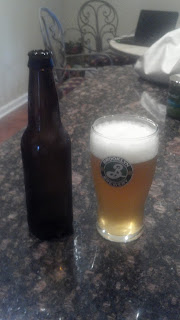Ingredients:
 |
| Uncle Jim hard at work! |
- 5.75 lbs. Domestic 2-row Pale Malt
- 2 lbs. ROI L Honey (from my Uncle Jim the beekeeper)
- 8 oz. of Cara-Pils/Dextrine
- 4 oz. of Honey Malt
- 1 oz. of Cascade Hops (60 minutes)
- 1 oz. of Falconer's Flight Hops (2 minutes)
- 1 tablespoon of PH 5.2 Mash Stabilizer
- 1/2 teaspoon of Yeast Nutrient
- 1 pkg. of American Ale Yeast (Wyeast Labs #1056)
- 1 Whirfloc tablet for clarifying
- 5 oz. of corn sugar for bottling (adds carbonation)
- 6.5 gallons of drinking water (double filtered at home)
- 20 lb. bag of ice (for quick cooling of wort)
Process (for all-grain batch sparging):
- Optional - Prepare a yeast starter at least 24 hours in advance of brew day.
- Clean and sanitize all equipment that will come in contact with your beer.
- Prepare your strike water by heating approximately 8 quarts of water (8.125 to be exact) or 2 gallons (or approximately 1.25 quarts of water per pound of grain) to a temperature of 162-170 degrees (10-18 degrees above target temperature to account for temp loss when added to grains). Aim for 169 degrees.
- Add all of of your strike water to the mash tun to heat it up and begin adding your crushed grains. Stir thoroughly to avoid dry pockets (dough balls).
- Once the mixture is thoroughly combined check the temperature to ensure it is approximately 152-154 degrees. If not, adjust by adding hot or cold water.
- Once your mash is at the proper temperature add pH stabilizer, stir and close the mash tun and let steep for 60 minutes.
- Prepare your sparge water by heating about 4.5 gallons of water (typically 1/2 gallon of water per pound of grain but increasing since honey is being utilized and is not added until later) to a temperature of 170 degrees. Be careful not to go over this temperature as tannins can be leached.
- Optional - check for starch conversion by performing an iodine test or simply taste the mixture. If conversion has taken place the mixture will taste sweet.
- Perform vorlauf by slowly collecting the first runnings of your wort and adding them back to mash tun. Take care to not let grain bed collapse by draining too quickly or dumping first runnings back in the mash tun with too much force. Repeat this step 2-5 times until the runnings are free of debris and running relatively clear.
- Collect your first runnings into your brew pot by allowing all of the wort in your mash tun to slowly drain out. Take your time and be careful to not let your grain bed collapse.
- After your mash tun has drained close the valve and add all of your sparge water to the tun and stir. Do not worry about disturbing the grain bed as you are going to create a whole new grain bed for the second runnings.
- Repeat Step 9 above (vorlauf) and collect enough wort until you have about 6 gallons of beer.
- Return your brew kettle to burner and bring wort to a vigorous boil.
- As soon as the beer begins to boil add 1 oz. of Cascade hops for bittering and boil for 60 minutes.
- With 15 minutes left in the boil add Whirfloc tablet and wort chiller (to sanitize).
- With 2 minutes left in the boil add 1 oz. of Falconer's Flight hops.
- During last 10 minutes of boil add 1/2 tsp. of yeast nutrient dissolved in small amount of warm water.
- Terminate boil and add the 2 lbs. of honey stirring until dissolved.
- Chill to fermentation temperature of approximately 70 degrees.
- Take a specific gravity reading and record.
- Estimated post-boil volume is 5.2 gallons. Optional - add water to achieve target SG.
- Transfer to fermentation carboy by siphon. Strain if desired.
- Optional - add water to achieve desired volume of 5 gallons.
- Pitch yeast and aerate well using pure oxygen.
- Attach blow-off tube or airlock and ferment until complete according to hydrometer readings (at least 3 weeks).
- Prepare priming sugar by boiling 2 cups of drinking water and add 3.9 oz. of priming sugar. Be careful not to scorch. Boil for 5 minutes and add to bottling bucket. Add wort, stir gently for 1 minute and bottle.
 |
| My dad - he's awesome!! |
Notes, Results and Lessons Learned:
- Brew Day - September 29, 2012
- Bottling Day - October 23, 2012 (24 days in Primary, no Secondary fermentation)
- Notes:
- Had to sub Citra hops for Falconer's Flight since my local homebrew supply store was out.
- This beer (on bottling day) turned out exceptionally clear.
- Time will tell... Taste test will occur the first part of November 2012. Stay tuned.
- So tasting day has come and gone and while I had high hopes for this beer it didn't turn out quite as I hoped. It wasn't bad but just didn't have that honey taste I had hoped. The more I have read about ales utilizing honey the more I have learned how tough it is to keep the honey influence in tact. For the most part, the honey is treated like any other sugar during the process and consumed by the yeast for food. What is left behind is not always what we expect. In any case, it was yet another learning experience. The beer will not go to waste...












